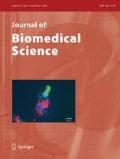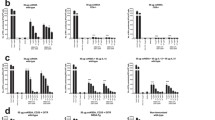Abstract
Our previous study showed dominant proliferative response of peripheral mononuclear cells to hepatitis C virus (HCV) nonstructural (NS-3) (T9, from aa 1188 to 1493) in chronically infected patients. Six T9-specific T-cell clones derived in an HCV patient were established and studied for the antigen specificity and the ability of augmentation of in vitro antibody production. All these cloned T-cell lines responded exclusively to T9 antigen and could help autologous B cells in producing anti-T9 antibody in vitro. Cytokine mRNAs of these T cells was detected by polymerase chain reaction and predominant IL-2 and IFN-γ production was noted. In addition, further elucidation of T-cell antigenic determinant and MHC restriction suggested that these T-cell clones recognized at least two different T-cell antigenic determinants within the NS-3 region in an HLA DQ2-restricted manner. We believe characterization of HCV-specific T-cell responses, especially T-cell epitope mapping and cytokine production pattern, may shed light on further understanding the pathogenic mechanism and designing therapy for HCV infection.
Similar content being viewed by others
References
Alter HJ. The hepatitis C virus and its relationship to the clinical spectrum of NANB hepatitis. J Gastroenterol Hepatol 1(suppl):78–94;1990.
Bartenschlager R, Ahlborn-Laake L, Mous J, Jacobsen H. Nonstructural protein 3 of the hepatitis C virus encodes a serine-type proteinase required for cleavage at the NS3/4 and NS4/5 junctions. J Virol 67:3835–3844;1993.
Bertoletti A, Sette A, Chisari FV, et al. Natural variants of cytotoxic epitopes are T-cell receptor antagonists for antiviral cytotoxic T cells. Nature 369:407–410;1994.
Biron CA. Cytokines in the generation of immune responses to, and resolution of, virus infection. Current Opin Immunol 6:530–538;1994.
Botarelli P, Brunetto MR, Miuntello MA, et al. T-lymphocyte response to hepatitis C virus in different clinical course of infection. Gastroenterology 104:580–587;1993.
Chen D-S, Kuo G, Sung J-L, et al. Hepatitis C virus infection in the area hyperendemic for hepatitis B and chronic liver disease: the Taiwan experience. J Infect Dis 162:817–822;1990.
Choo Q-L, Kuo G, Weiner AJ, Overby LR, Bradley DW, Houghton M. Isolation of a cDNA derived from a blood-borne non-A, non-B viral hepatitis genome. Science 244:359–362;1989.
Chromczynski P, Sacchi N. Single-step method of RNA isolation by acid guanidinium thiocyanate-phenol-chloroform extraction. Anal Biochem 162:156–159;1987.
Clerici M, Hakim FT, Venzon DJ, et al. Changes in interleukin-2 and interleukin-4 production in asymptomatic, human immunodeficiency virus-seropositive individuals. J Clin Invest 91:759–765;1993.
Clerici M, Shearer GM. The Th1–Th2 hypothesis of HIV infection: new insights. Immunol Today 15:575–581;1994.
Diepolder HM, Zachoval R, Hoffmann RM. Possible mechanism involving T-lymphocyte response to non-structural protein 3 in viral clearance in acute hepatitis C virus infection. Lancet 346:1006–1007;1995.
Farci P, Alter HJ, Govindarajan S, et al. Lack of protective immunity against reinfection with hepatitis C virus. Science 258:135–140;1992.
Ferrari C, Valli A, Galati L, et al. T-cell response to structural and nonstructural hepatitis C virus antigenic in persistent and self-limited hepatitis C virus infection. Hepatology 19:286–295;1994.
Hwang L-H, Yang P-M, Lai M-Y, et al. Identification of humoral antigenic determinants within the hepatitis C virus NS3 protein. J Infect Dis 174:173–176;1996.
Koziel MJ, Dudely D, Wong JT, et al. Intrahepatic cytotoxic T lymphocytes specific for hepatitis C virus in persons with chronic hepatitis. J Immunol 149:3339–3344;1992.
Kuo G, Choo QL, Alter HJ, et al. An assay for circulating antibodies to a major etiologic virus of human non-A, non-B hepatitis. Science 244:362–364;1989.
Miyamura T, Saito I, Katayama S, et al. Detection of antibody against antigen expressed by molecularly cloned hepatitis C virus cDNA: Application to diagnosis and blood screening for posttransfusion hepatitis. Proc Natl Acad Sci USA 87:983–987;1990.
Mosely JW, Aach RD, Hollinger FB, et al. Non-A, non-B hepatitis and antibody to hepatitis C virus. J Am Med Assoc 263:77–78:1990.
Nakatsuji Y, Matsumoto A, Tanaka E, et al. Detection of chronic hepatitis C virus infection by four diagnostic systems: first-generation and second-generation recombinant immunoblot assay and nested polymerase chain reaction analysis. Hepatology 16:300–305;1992.
Nasoff MS, Zebedee SL, Inchauspe G, Prince AM. Identification of an immunodominant epitope within the capsid protein of hepatitis C virus. Proc Natl Acad Sci USA 88:5462–5466;1991.
Okamoto H, Sugiyama Y, Okada S, et al. Typing hepatitis C virus by polymerase chain reaction with type-specific primers: Application to clinical surveys and tracing infectious sources. J Gen Virol 73:673–679;1992.
Okamoto H, Kurai K, Okada S, et al. Full-length sequence of a hepatitis C virus genome having poor homology to reported isolates: Comparative study of four distinct genotypes. Virology 188:331–341;1992.
Powrie F, Mason D. Phenotypic and functional heterogeneity of CD4+ T cells. Immunol Today 9:274–277;1988.
Reed SG, Scott P. T-cell and cytokine responses in leishmaniasis. Current Opin Immunol 5:524–531;1993.
Schupper H, Hayashi P, Scheffel J, et al. Peripheral-blood mononuclear cell response to recombinant hepatitis C virus antigens in patients with chronic hepatitis C. Hepatology 18:1055–1060;1993.
Shirai M, Okada H, Nishioka M. An epitope in hepatitis C virus core region recognized by cytotoxic T cells in mice and humans. J Virol 68:3334–3342;1994.
Tomai L, Failla C, Santolini E, De Francesco R, La Monica N. NS3 is a serine protease required for processing of hepatitis C virus polyprotein. J Virol 67:4017–4026;1993.
Weiner AJ, Geysen HM, Christopherson C, et al. Evidence for immune selection of hepatitis C virus (HCV) putative envelope glycoprotein variants: potential role in chronic HCV infection. Proc Natl Acad Sci USA 89:3468–3472;1992.
Yang P-M, Hwang L-H, Lai M-Y, et al. Prominent proliferative response of peripheral blood mononuclear cells to a recombinant nonstructrual (NS3) protein of hepatitis virus in patients with chronic hepatitis C. Clin Exp Immunol 101:272–277;1995.
Author information
Authors and Affiliations
Rights and permissions
About this article
Cite this article
Chiang, BL., Yang, PM., Hwang, LH. et al. Establishment and characterization of NS3 protein-specific T-cell clones from a patient with chronic hepatitis C. J Biomed Sci 5, 290–296 (1998). https://doi.org/10.1007/BF02255861
Received:
Accepted:
Issue Date:
DOI: https://doi.org/10.1007/BF02255861




